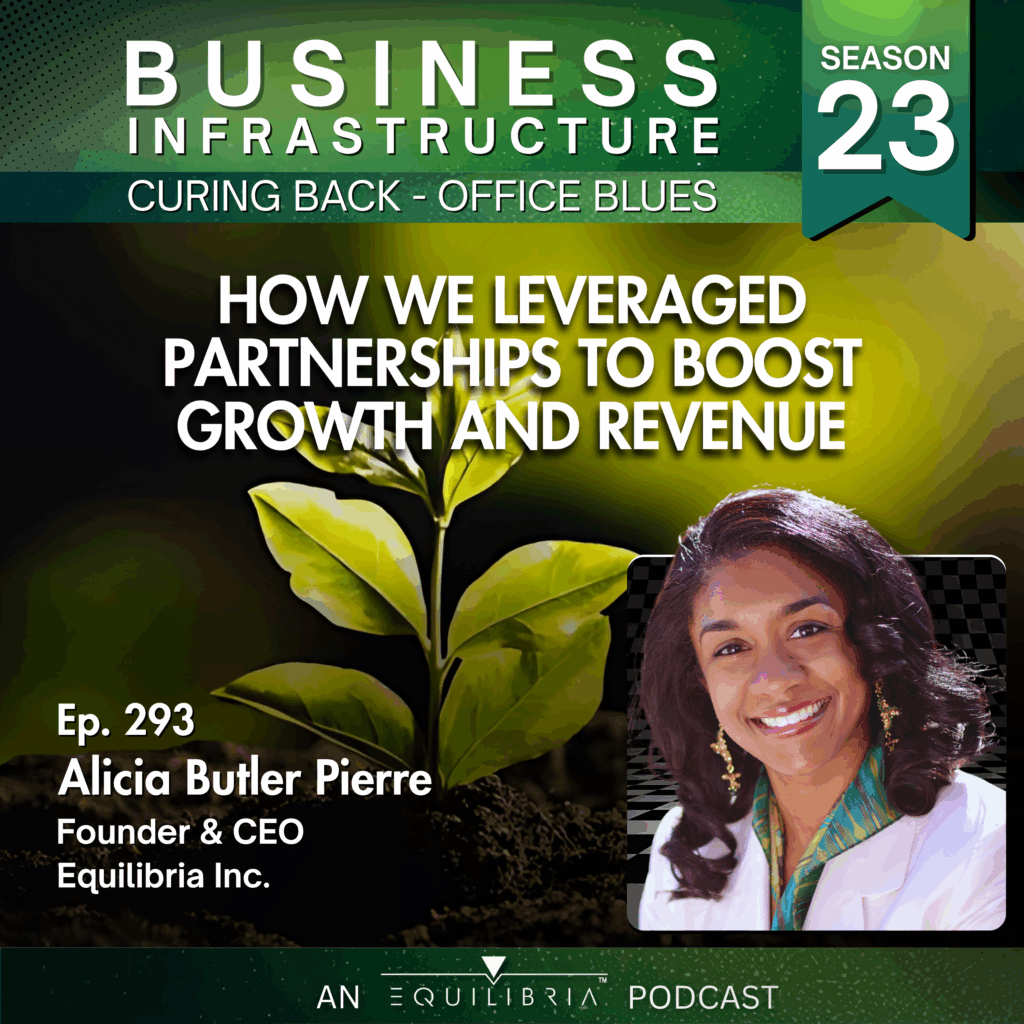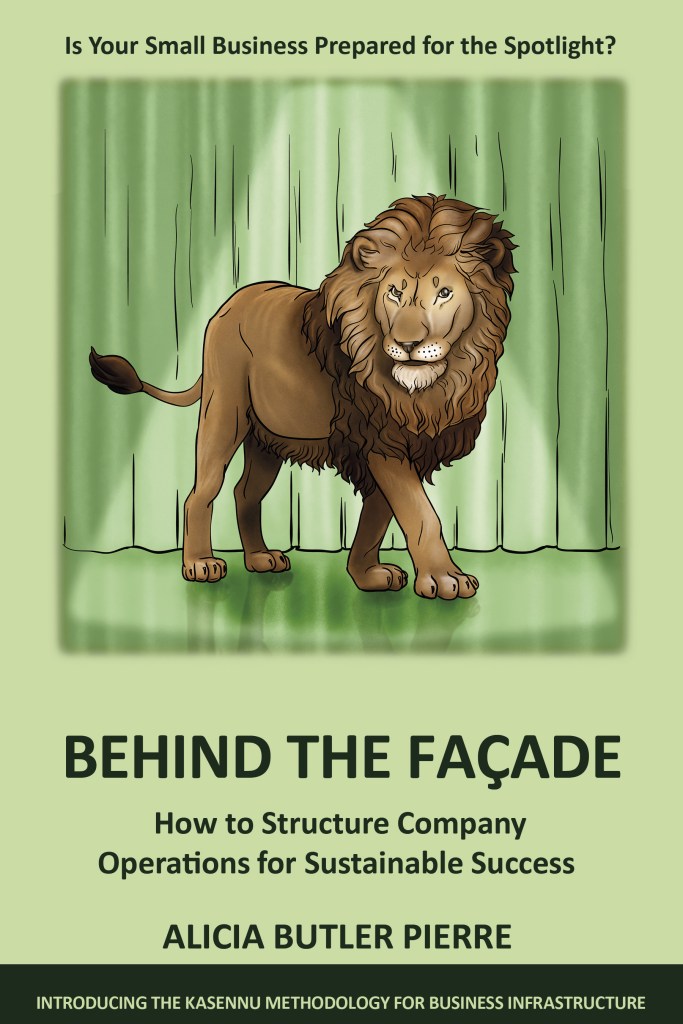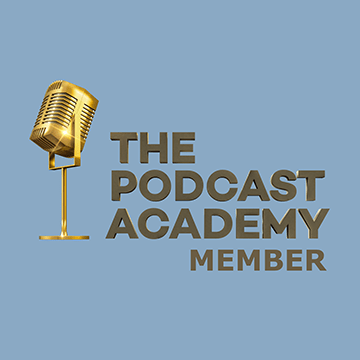Transcript
Welcome back to Season 23 of the Business Infrastructure Podcast. On this show, we share operational tips, tactics, and strategies to help you cure any back-office blues you might be experiencing.

This season is all about growth strategies and we’ve structured it as a masterclass featuring experts and tools to scale your operations, revenue, and profitability. As each subject matter expert is interviewed, I follow up with a monologue like the one you’re about to hear so that you have the benefit of knowing how to apply the information
shared by each expert.
As you know there are many ways to grow a business. Here at Equilibria, the underwriter of this podcast, our focus is on partnerships as a way to grow and scale.
In the last episode, you learned about the legal details that go into forming a partnership. In this episode, I’ll share with you what some of those details look like as well as specific things we took into consideration in forming different types of partnerships.
This is Ep. 293: How We Leveraged Partnerships to Boost Growth and Revenue
Hi there! It’s great to be with you one-on-one again. If you’re new to the show, welcome! I’m Alicia Butler Pierre, Founder and CEO of Equilibria. Again, Equilibria is the underwriter of the business infrastructure podcast.
If you’ve been following along with the episodes in this growth strategies masterclass then you know that we had an idea for an online course.
Promoting this course has led us down a strategic growth path we did not expect, but it’s a good thing. That path included vetting the online course with a level of scrutiny that was painful, yet necessary.
We then used that as a cornerstone for developing a growth strategy and then project plans to make sure we accomplish our ultimate goal to transition the business model from consulting to training.
Something that became clear was how important partnerships would be in making this transition. It also serves as a catalyst for growth.
Thankfully, I have a great network that includes people that I could plug into this vision I had for partnerships.
Even as I say that, I have to laugh because the funny thing is that it sounds so simple, yet the execution of the contracts required to make these partnerships a reality took way longer and ended up being far more complex than we could have ever imagined!
I’d like to give you some of the details in how we worked with Karen Mills. And for those of you, if you did not have the opportunity to listen to Karen’s episode, I highly encourage you to go back into our catalog of episodes and make sure you listen to that episode. There’s so much valuable information there. That’s episode 292 with Karen Mills. She’s specifically talking about teaming agreements.
Now, keep in mind, Karen and I have known each other, gosh, maybe twelve years or so, if not longer, 12, 13 years. I first met her when I attended a workshop on how to secure contracts with the federal government. I remember taking such copious notes when I
met with Karen, and I always held on to those notes because something told me in the back of my mind that one day I would in fact work with Karen. And that day came early this year, in 2024, back in January. So again, remember, we’re going along this strategic
growth journey at this point.

We had worked with Martina over the past couple of years on a lean canvas. We had the information we needed to proceed with going with this online course. We worked with Kenya Moses in using the X-matrix to help us develop an actual strategic growth plan that included the online course. And then we started working with Jon Reid to develop project plans to actually help us implement our strategic growth plans or make sure that we would accomplish our objectives and goals. Well, again, keep in mind my word for
this year with my team here at Equilibria is partnerships.
As Karen said in the interview, I’d rather have a sliver of a piece of pie than to have nothing. And I always say it’s better to have 10% of something than 100% of nothing. And partnerships, again, really are going to help us here at Equilibria, take our growth goals to the next level, and we’ll get there so much faster. But in order to get there, it required forming these partnerships, these different types of teaming agreements, as Karen would correct me in saying. And there are different types of teaming agreements.
So what I’m going to do, out of respect for Karen and her intellectual property, because Karen does give you an incredibly robust checklist of items that you need to consider if you are thinking about going into any type of teaming agreement with another entity.
And again, “entity” could mean another individual or an actual organization, a company, a nonprofit, whatever the case may be. I’m going to share my screen here. I’m on Zoom. For those of you who are just listening to the audio, make sure you go and check out
the video.
If you are able to actually watch the video, that would be even better. But if you can’t, I am going to do my absolute best to give you a visual of what I am about to sketch out. So I’ll share my screen here. I’m on Zoom again, and I am using a digital notepad, which
is called a reMarkable. And I’m going to just sketch out what the process looks like in working with Karen.
So we’ll call this. I’m writing at the very top of my notepad here, my digital notepad. This is the “partnership process.”
Okay. And I’ll just kind of underline it here to make sure everyone knows this is what we’re about to talk through. The very first thing that we did. And I’m going to kind of construct this as a flow diagram, if you will. The very first thing that I did was I scheduled an initial consultation with Karen.

So that was the very first thing that I did. And she does offer, I believe it’s a free 1-hour consultation. We did that via Zoom. Even though Karen and I are both located here in Atlanta because of traffic, it just makes more sense and it’s more efficient to meet via
Zoom. So that was perfectly fine.
And she’s so good at understanding what your business objectives are. So I mentioned to Karen the things that I’ve just shared with you all, the fact that we are transitioning the business’s model from consulting to training. We’re going to really take, lean into online courses and possibly even delivering some courses in person. And the fact that we want to work with another company that already has a learning management system set up, which is known as an LMS, potentially even being able to white label some, some of their course materials. Again, why start from scratch if others have already created the materials?
But we also wanted to be able to partner with companies that already have some of the connections in the us federal government space, as well as with large corporations, because that is going to be the target audience for our online courses. And then we would need to work with a team of independent instructors. Again, remember, we want to scale. It won’t just be me, little old me, doing all of this training, because obviously that would defeat the purpose we want to scale. And in order to scale, it would be great if we could have several contracts with several people instructing at the same time.
That would be the ultimate goal. Again, that is how we would achieve scale with this new business. Model. So one of the first things she told me as we started to wrap up that initial consultation after she heard about the strategic growth goals, she said, Alicia, you know, there’s really three types of agreements that are at play here. So that’s what I’m going to draw here next.
There’s three agreements. And again, keep in mind, this is specifically for Equilibria’s situation. So your situation could be different. So there’s three agreements. There’s, I’m going to draw here this little schematic.
This is, this is supposed to be a database, and I’m going to draw the letters lms in the middle of that database symbol. But the first type of agreement is an agent agreement. The agent agreement is the agreement that would be in place with the companies that we want to partner with that already have these learning management systems in place. In other words, these are online platforms that future students would be able to log into. They would be able to review the course materials.

They could watch videos, they could, I could conduct live sessions myself and other instructors. That is what a learning management system is. And other companies already have the technologies in place with those things set up. So that company would actually send my company, Equilibria, an agent agreement. That would be an agreement between our two companies with the understanding that we don’t, we being equilibria, does not own the learning management system, but we simply would be able to tap into that system and pay them some type of fee.
So that’s what that’s about. So that is a situation where my company would not draft the legal agreement. It would be us receiving the agreement, the agent agreement from that company or from that entity. And Karen would actually help in that review process. She would be able to look over that agreement and point out some things that may be concerning for her.
And that’s when the negotiation process would begin. That is for the agent agreement. So I’ll just put here in parentheses under agent agreement, the word review, because again, that’s not something that is being created from scratch. On Equilibria side, the second type of agreement is I’m going to draw here a funnel. This is like a sales funnel.
And I’m writing the words sales funnel next to this awful diagram that I just, this awful symbol that I just drew. And the second type of agreement is a solicitation agreement. And let me explain what that means. This is also a teaming agreement that will be created. I’ll write the word create in parentheses underneath solicitation agreement.
This is the primary agreement that is going to be in place for equilibria. This is the agreement that I will have in place with other organizations that already have those relationships with federal government agencies, us federal government agencies, as well as large corporations, because again, we want to train and we want to train as many people as we possibly can. So yes, it’s great to be able to train people one on one or individually, but it’s even better if we could train 100, 501,000 people in one fell swoop via some type of contract. So these are another type of partnership agreement. The reason it’s called solicitation agreement is because we are specifically talking about going in on projects together.
They would form, the other entity would actually collect a management fee, whereas Equilibria would provide the actual training. So remember when Karen said teaming agreements aren’t necessarily about splitting money 50 50, it could be a 2080 relationship, 30 70%. And that is actually a term that my company and some of the other entities that we are working with in forming these solicitation agreements. That is one of many negotiating factors that we are taking into consideration. The third type of agreement for Equilibria is, and I’m going to draw a little stick figure here, is the instructor agreement.

This is a type of independent contractor agreement, and this is also something that Karen would create for Equilibria. The independent instructor agreement is all about all these, this network of people that I know who also have the training skills and experience, and I could literally plug them into some of these contracts if they are awarded into these training situations. So that is the instructor agreement. Again, it’s really drafted as an independent contractor agreement. And that is yet again something that Karen would actually create for Equilibria.
So here’s what happened. Once she shared all of this amazing information with me during the initial consultation, I then had time to review it. She sent me a proposal, and once I signed that proposal and made an initial deposit payment, that put me on Karen’s in her queue, so to speak. And I always love it when she says, okay, I’m confirming receipt, Alicia, of your signed contract with me, and I’ve received the payment. And so now I can actually put these two different agreements that will be created from scratch into my queue.
So I would say, let’s focus specifically on the second type of agreement, which is that solicitation agreement, because that’s really the one that took the most amount of time. So I’ll just draw a really thick arrow here extending from the solicitation agreement, because that’s the one we’ll focus on, and I’m writing here, next, initial draft. Whoops. It would help if I could spell that correctly, initial draft. And it took about, I would say, maybe two weeks before I received that initial draft.
And these are some of the things that Karen included, non-disclosure agreement clause. There’s a clause in there for intellectual property protection. There’s a clause in there for non-circumvention or first right of refusal. And don’t worry, I’ll explain what all of these things mean. There’s something in there about non solicitation.
There’s also something about permission to use image and likeness. There are many other clauses, but I specifically wanted to point these out because I think it’s so important to share my logic in specifically requesting that those clauses be included in this solicitation agreement. Now, I should also share with you that I often look to the entertainment industry for lessons learned that I can apply to my own business, believe it or not. So, I specifically have studied artists like Prince and Taylor Swift. These are artists who are, you know, well renowned, world renowned, excuse me.
And they have fought the music industry, and they have won, especially when it comes to owning their masters, owning their creative work that they put blood, sweat, and tears into, but then also owning the masters of that work as well, to maximize their own revenue and scale their own revenue. So it was important to include those different clauses, and I’ll write those down here. So, again, it was the NDA, which is a nondisclosure agreement, meaning my company, as well as the company that I would enter into a solicitation agreement with. There is an agreement that we will not disclose any proprietary information about our work together, or that also covers. There are some specific intellectual property things that we have going on here at Equilibria, that if we were to disclose that to the other company or the other entity, it would be damaging for us, and we would.

It would be very difficult for us to recover financially. So the clause is actually written from a mutual perspective, meaning we both are agreeing that we will not disclose each other’s proprietary and confidential information.
So IP protection goes, again, hand in hand with that. And at Equilibria, we have quite a bit of intellectual property that requires protection. So that’s copyrights, trademarks, service marks, as well as a trade secret that we would likely have to divulge elements of
in the execution of some of these solicitations, the permission to use image and likeness. Let me explain what that’s about. There have been moments in the past where people have told me, oh, Alicia, I didn’t realize you were a part of the such and such organization, or I didn’t realize you were part of that particular project.
Because people, once they receive your bio and your headshot, they can actually leverage that information to secure business for themselves without your knowledge. So I wanted to make sure that there was a very specific clause in this agreement that said, again, from a mutual perspective, that we agree that if we ever want to use each other’s image and or likeness, we have to do so get seek permission first in writing. That’s something else that Karen is a stickler for. Don’t ever talk about or discuss things verbally. Always get it in writing.
That is your best line of defense. In the event someone does not honor what is discussed, you have it in writing. Both people sign off on it, and both people are in agreement. When it comes to non solicitation, this is about not soliciting business. Each other’s clients or each other’s employees, independent contractors, team members, this is something else that can oftentimes happen.
And if you don’t have that clause specifically in your contract, someone could ideally that you enter into an agreement with, they could ideally poach people from your team. And if you don’t have that clause in place to protect you for a certain period of time, like, let’s say 18 months to two years after the agreement is signed, then that is something else that could in fact be catastrophic to your daily operations. And then finally, I’m going to link together non circumvention as well as first right of refusal. And what that means is simply, it is possible that my company, which would be considered a subcontractor, and the company that we are entering into the solicitation agreement with, they would be considered the prime contractor, because again, they already have these important corporate and or government, federal government relationships. So they would be the face, and then Equilibria, as a subcontractor, would actually be the organization to deliver the training.
If we take the time to craft a proposal together, or a statement of work, or a solicitation. In this instance, what the first right of refusal and a non-circumvention clause is essentially saying is that if that contract is awarded, we want to have the right to bid on it first or
participate in it first. And if there’s a situation where at equilibria we are at maximum capacity, we simply can’t take on a new project at that time, then that prime contractor has the right to go and seek another company that offers comparable training and services. But what we’re saying in this clause is don’t go around us in a weird kind of roundabout way, have us do all of the upfront work to put together a proposal, and then if that contract is actually awarded, we don’t have the benefit of being able to do the work. So that’s what this clause is about.
And again, this is something really important, something that I’ve personally seen other companies get burned with the past. So after this initial draft, and we were using, this was in Microsoft Word, Karen is really great about using the comments and track changes feature. She said, Alicia, I want you to focus obviously on every single line in this contract. And that took a while, I have to tell you, because you have to make sure that you have your full concentration at play there. But there are, there are some things that I do want to share with you that are important in any type of contract.
So I’ll go ahead here and switch over to Microsoft Word. And what I did here was I just kind of copied and pasted those important elements. Not that the entire contract isn’t important, but the things that Karen really stressed for me, the first being the preamble,
this is literally the very first paragraph of any legal agreement. So you can see here it says this exclusive teaming agreement for responding to a solicitation in parentheses. This agreement is made this blank day of blank, 2024.

That’s where you would fill in the day of the week and the month, which is the effective date. This is literally saying, this is the date in which this agreement goes into effect by in between, again, there’s a blank there, a Georgia corporation with its principal office located at, and this is the prime contractor. So these blanks would be filled in with the name of that other contractor, that, that other entity. Excuse me, again, it could be an individual or it could be an actual organization, and then the state in which that organization, because we’re talking about the US here, so we have states, it would be the specific state state in which that other entity is located.
So the agreement is between that entity and Equilibria, Inc., which is a Georgia corporation with its principal office located at. Blank won’t give the actual physical address here for confidentiality reasons, but we again are considered as the subcontractor in this relationship. And then the last sentence of this preamble simply states, the prime contractor and subcontractor are referred to herein individually as the quote unquote party or collectively as the parties. In other words, throughout the rest of this agreement they’re not going to spell out the name of the company. They’re not going to spell out the name of Equilibria.
We will either be referred to as the party or parties plural. The second section of the teaming agreement is the body. That’s where all of those different clauses that I just went through are contained, in addition to many, many other clauses. And then the final part of this teeming agreement is the signature block. And this is where, as you can see here, there is a section for the prime contractor to enter his or her name as well as provide a signature, as well as that person’s title and the subcontractor note that we don’t just put CEO or COO or CFO, you actually spell out the full title.
So instead of CEO, it is chief executive officer. That’s something else that I’ve learned from Karen, the importance of being able to spell out the full title, because in some instances, CEO might mean something completely different. And so that’s the reason why it’s spelled out there. So I’ll go back now to our flow diagram here. So we were at the review stage, or I’ll just say review, reviewing that initial draft.
And then honestly, after that initial review, believe it or not, there were three other drafts that we went through together before it was actually finalized, which is one of the last steps here in this process. Once it was finalized, I literally had to sign off, or I believe it was an email that Karen asked, I literally need you to type in your email that you approve this final draft. And then she released two different versions of the contract to me. She released the one that had all of the track changes features still activated in Microsoft Word, as well as the comments. That way we could look at the historical for it for historical purposes, we could look at how the contract evolved over the different versions of it.
But then she also sent what I refer to as a clean version, one that does not have the track changes feature activated at all. That is the version that I am to use for every solicitation agreement that I want to enter into with another entity. And so once it’s been finalized, we send to the other party, and believe it or not, as of this recording, this is actually quite literally the stage that we’re at right now, which is it’s been sent to another party, and we are literally waiting for their feedback because after that we could go through some rounds of negotiations. So I’ll just draw another arrow here. This could be a possibility to negotiate on some of the terms that are stated in the clauses of the contract.
And then we would just literally go back to, we would circle back to finalizing the contract. It has taken five months. So keep in mind, we started this effort at the beginning of February 2024. And as of this recording, it is June 2024. So it’s been five months.

And you may be asking yourself, why on earth did it take so long? But you have to keep in mind, you still run a business. You still are fighting fires throughout the day. You have different deadlines and deliverables that you have to meet. You have clients that you have to appease.
You have business development activities that you have to still engage in. And when you are reviewing contracts like this, you want to make sure you can give your full, undivided attention to this matter, because one line, literally one line in a contract could make all the difference in the world. So you want to make sure that you review it many, many times. It honestly reminded me of when I wrote my book and all of the rounds of editing that I had to go through and reading the manuscript over and over and over and over, it was exhausting. And so that’s honestly why it took five months.
So I’m glad that I had this opportunity to share with you in an illustrative way what the process actually looks like. And so now that you know that, we’ll go ahead and wrap up this particular episode. If you have any questions about teaming agreements, their formation, different clauses to make sure you have included, please reach out to Karen. I’ll definitely make sure that we have her information in the show notes.
Thank you for listening! Visit BusinessInfrastructure.TV to watch the video version of this episode. Again that’s BusinessInfrastructure.TV.
If you are enjoying being a part of this growth journey with us, then please subscribe to the show, give us a five-star rating and…we’d love it if you left us a review.

Are strategic partnerships a part of your growth strategy? If so, then I highly recommend contacting Karen Mills. I guarantee you that an hour spent with her will be an excellent investment and, it can potentially save you from a legal disaster. We’ll include links to Karen’s website and LinkedIn profile in the show notes.
As a reminder, we’re going to talk about another growth strategy or shall I say, an exit strategy? You’ll learn about the business infrastructure and financials required to sell your business for maximum value.
Be sure to come back to the place wherever you’re listening so you don’t miss it! Until then, remember to stay focused and be encouraged. This entrepreneurial journey is a marathon and not a sprint.
This podcast episode was written and produced by me, Alicia Butler Pierre. Audio editing and sound design by Sabor! Music Enterprises. Video editing by Gladiola Films. A special thank you to the team here at Equilibria, Inc., and to Grant Revilla for creating the show notes.
This is the Business Infrastructure – Curing Back-Office Blues podcast


















